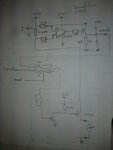thunderdantheman
Member level 4
G'day,
I'm trying to build a high speed high-side current sense amplifier and while searching out possible candidate op-amps I came across the LT6016/LT6017. The datasheet http://cds.linear.com/docs/en/datasheet/60167fa.pdf shows an application circuit of a high side current monitor with a FET output... (I've included the circuit below) now I can't work out how or why it works.. i'm probably missing something really simple but i'm rather stumped atm! any one care to explain it's operation?

I'm trying to build a high speed high-side current sense amplifier and while searching out possible candidate op-amps I came across the LT6016/LT6017. The datasheet http://cds.linear.com/docs/en/datasheet/60167fa.pdf shows an application circuit of a high side current monitor with a FET output... (I've included the circuit below) now I can't work out how or why it works.. i'm probably missing something really simple but i'm rather stumped atm! any one care to explain it's operation?


